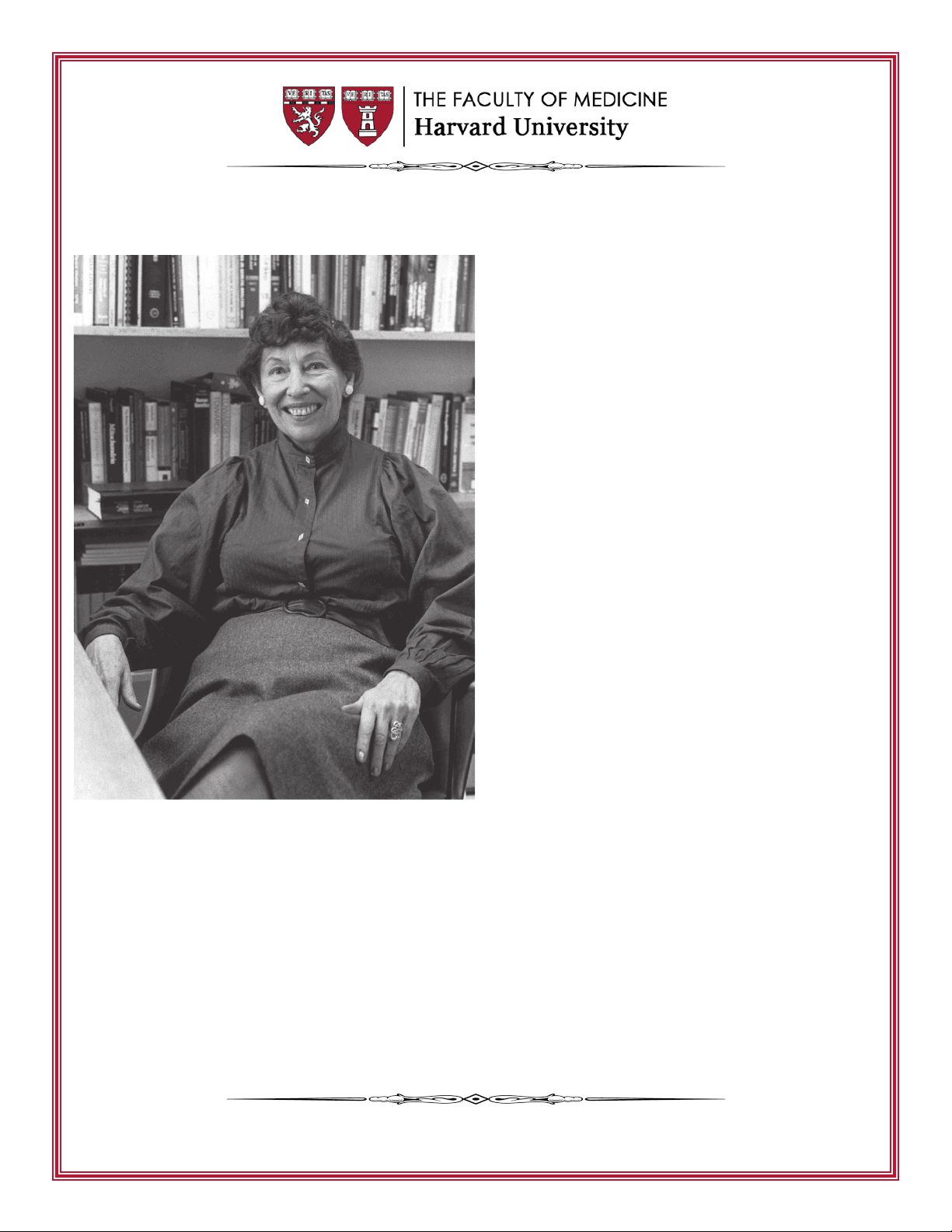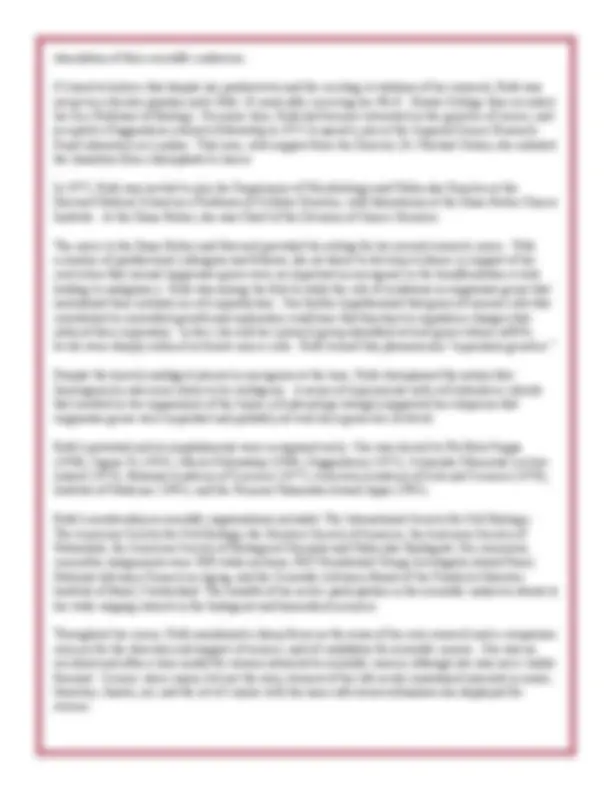




Study with the several resources on Docsity

Earn points by helping other students or get them with a premium plan


Prepare for your exams
Study with the several resources on Docsity

Earn points to download
Earn points by helping other students or get them with a premium plan
Community
Ask the community for help and clear up your study doubts
Discover the best universities in your country according to Docsity users
Free resources
Download our free guides on studying techniques, anxiety management strategies, and thesis advice from Docsity tutors
The life and work of Ruth Sager, a gifted scientist who made significant contributions to the field of genetics and cancer research. It details her education, research, and collaborations with other scientists, as well as her discovery of uniparental inheritance in chloroplasts. insight into the life of a pioneering female scientist and her passion for exploring the natural world.
Typology: Study notes
1 / 4

This page cannot be seen from the preview
Don't miss anything!



Ruth Sager should be remembered above all as a gifted, original, and imaginative scientist who loved her life of exploring nature, and in her later years, brought her gifts and passion to investigating the scourge of breast cancer. Her discovery of science came through an epiphany. She enrolled at the University of Chicago with the intention to study music or literature. The University’s insistence on a broad liberal arts education brought Ruth to courses in biology, where she is said to have encountered the physiologist, Professor Anton Carlson, and was so taken by his course in physiology that she switched her major to biology and her concentration to physiology. She found all her science courses stimulating and at first thought medicine would be her career choice. Having received her B.S. (Phi Beta Kappa) from the University in 1938, Ruth spent the war years first as a secretary, and later in a graduate program at Rutgers University, where she participated in a wartime research project. She obtained her master’s degree in Plant Physiology in 1944. The title of her master’s thesis was “Nutritional Status of the Tomato Seedling in Relation to Successful Transplanting.” The taste of research and her duties as a teaching assistant at Rutgers convinced her that a life of laboratory research and teaching was her true calling, so she enrolled in 1945 for a Ph.D. at Columbia University, and wisely selected genetics as her field. Professor Marcus M. Rhoades was her thesis advisor, and the genetics of corn her special area. It proved her good fortune to have selected an area graced by one Barbara McClintock, who, along with Professor Rhoades, strongly influenced Ruth’s scientific development. A Merck fellowship awarded for a postdoctoral period with Dr. Sam Granick, a microbiologist that the Rockefeller Institute for Medical Research, permitted Ruth to spend the summer at the Hopkins Marine Station at Pacific Grove, California. There she took the highly regarded course of Professor Van Niel In tribute to their dedicated efforts to science and medicine, deceased members of the Harvard Faculty of Medicine (those at the rank of full or emeritus professor) receive a review of their life and contributions with a complete reflection, a Memorial Minute.
as a first step in preparation for her planned change of focus to microorganisms. Her intention was to concentrate on the chloroplast, and with the help of Professor Van Niel and Professor Gilbert Morgan Smith, she selected the single-celled flagellated alga Chlamydomonas reinhardi as the focus of her research. At the termination of her fellowship with Dr. Granick, Dr. Sager continued her work on the chloroplast as a staff member at the Rockefeller Institute until 1955, when she moved to Columbia as a research associate and later (60-66) as a senior research scientist in the Zoology department. Her time spent in the laboratory of Professor Francis Ryan made for a rich exchange, and led to her most productive research on chloroplast DNA and ribosomes. In addition, Ruth and Professor Ryan collaborated on the successful textbook Cell Heredity , which was published in 1961. In the first decade of the 20th century, Carl Correns found in his studies with Mirabilis jalapa var, albomaculata, the four-o’clock plant, that chloroplast traits such as greenness are not all transmitted according to the rules of Gregor Mendel. Instead, such characters are inherited only from the maternal parent. It was suggested that the trait was passed along through chloroplasts. Such a suggestion implied that these organelles had an independent genetic system. This was implication, not evidence. At mid- century many geneticists, including some very influential scientists, were almost dismissively doubtful that such an independent system existed. Ruth started on a course of research that led to her demonstrating that uniparental inheritance really does occur. Guided by contemporary work in microbial genetics, she generated streptomycin-resistant mutants of Chlamydomonas and, by making the appropriate crosses, determined that one of these mutations was inherited from only one of the two Chlamydomonas mating types. Then, she isolated additional mutants with uniparentally-transmitted traits, and proceeded to establish a genetic linkage map for them by cleverly finding a way to temporarily block uniparental inheritance! This work showed that non-Mendelian uniparental inheritance is real and that there are two independent genetic systems in Chlamydomonas (we now know that there are three). The knowledge that some chloroplast functions were blocked by the very antibiotics to which resistance could be shown in some of Ruth Sager’s uniparental mutants strongly suggested that the uniparental genetic system was associated with chloroplasts. Firm evidence for this association came with the identification of DNA as the genetic material in 1953, the unequivocal demonstration of the presence of DNA in chloroplasts in the early 1960s, and the physical identification of specific chloroplast genes in the 1970s. After showing that the uniparental genetic system exists alongside the nuclear genome, Ruth Sager went on in the 1960s and early 1970s to investigate the mechanism for uniparental inheritance of chloroplast genes. Her second book, Cytoplasmic Genes and Organelles , published in 1972, was the culmination of two decades of her pioneering work on the chloroplast of Chlamydomonas reinhardi. Her work was marked by boldness, originality, thoughtfulness, and enthusiasm. It brought her great pleasure, which she graciously shared with those who knew her. Ruth was born in Chicago on February 7, 1918. She was one of three daughters of Deborah and Leon Sager. Ruth graduated from New Trier High School in Winnetka, Illinois, at the age of 16, and entered the University of Chicago. Her parents were very appreciative of literature and the arts, and it was natural for Ruth to consider those fields options for her college major. In fact, throughout her life she enjoyed collecting art, especially modern art in later years. In 1944, she married Seymour Melman, an economist, and in 1973 was married a second time to Arthur Pardee, a marriage that fostered mutual
Of her career as a scientist Ruth was quoted as saying: “Science is very demanding. You have to really love it. Science is a way of life. I think it all comes from inside. It really gets to the very core of your existence. It is much like being an artist or a dancer.” Respectfully submitted, Harold Amos, Chairperson Lawrence Bogorad Lan Bo Chen Ruth W. Craig Ann Hochschild Roberto G. Kolter Charles D. Stiles